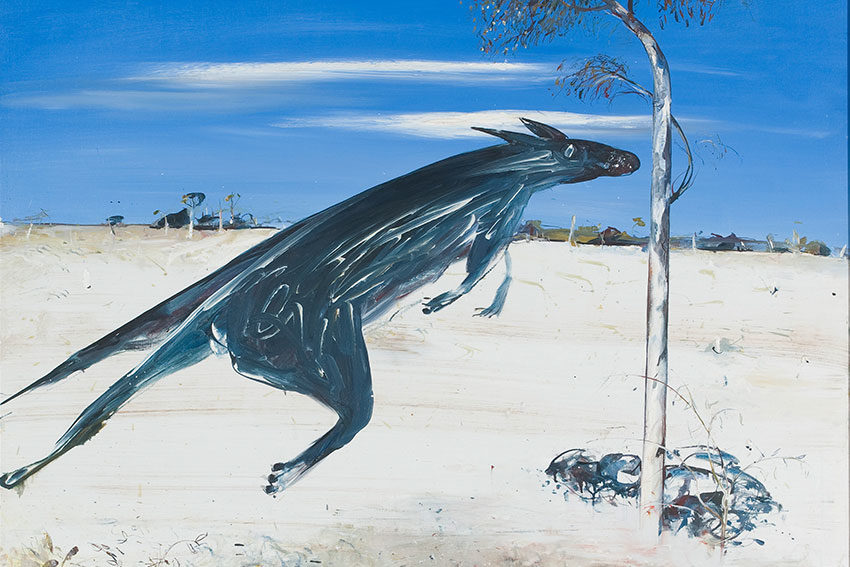The interior landscapes of Arthur Boyd

A touring Arthur Boyd exhibition presents a significant opportunity to refresh and re-evaluate the work of an Australian master.
Imagine the topography of modern Australian art as a primal landscape. The earth is heaving with historical aftershocks as the dark truths of the frontier wars are progressively revealed. Fissures appear along fracture lines as contemporary Indigenous artists rise up and present alternative histories and perspectives. At times the intensity of expression and message flows like red hot lava, altering the landscape forever. That’s the now of the contemporary scene. Just find a solid rock on which to stand and hold on. From this vantage point the topography of earlier periods, even the revolutionary early to mid- 20th century era, looks comfortingly peaceful. The heat of ideological and cultural turf wars has cooled. They are like the Queensland Undara lava tubes, which you can walk through, wrapped by outer shells formed as the flow cooled.
Looking at art of half a century ago is something like this – deposits on the inner skins of gallery walls – evidence of a flow of ideas, now cooling their heels. But do some artists remain hot and ‘keep flowing’? Arthur Boyd certainly. Along with others of his generation (Nolan et al) Boyd represented, for aspiring young artists in the 1960s, a model of what art should be about – defiantly different to all the Australian art that had gone before. When Nolan populated his ‘Australian’ landscapes with mytho-poetic figures, emerging local artists were inspired. Boyd also fuelled this hunger for new, creative narratives about Europism Down Under. But he was, and remains, remarkably different, as this obsidian-sharp exhibition demonstrates.

The Barry Pearce-curated exhibition Arthur Boyd, Landscape of the Soul, presented at the National Art School, Sydney, and now on regional tour, is a significant opportunity to refresh and re-evaluate Boyd’s relationship to the contemporary ‘now’. It’s the quintessential selfie. Everything about Boyd is about the inner life and therein lies his enduring appeal to the contemporary imagination. Pearce says that he did not want to do “any old landscape exhibition”, but one that encapsulated the artist’s “inner self” – the landscape he felt as well as the landscape he saw. Despite the fact that Boyd populated his recognisably Australian landscapes with figures drawn from Classical mythology, the Old Testament (such as Nebuchadnezzar series) Renaissance painting and assorted ‘angels and demons’, the themes and central subjects were always about his passions, fears, nightmares and relationships.
Commenting on Boyd’s uncompromising gaze on all that human experience can deliver, Pearce says: “He believed that you should confront the bad side and not turn away from it … Painting in the end for him was a kind of a vaccination against the evil.”
So intense is his engagement with the dark side that the forms and surfaces of his painting boil and surge like waves breaking on rocks. The wonder of it is not so much that he worked in such charged manner, but that he sustained this energy across a lifetime of work. Pearce recalls seeing Boyd at work, very late in his life, applying pigment with his hands in bold gestures, as if life depended on it.
Landscape of the Soul is drawn mostly from the Bundanon Trust’s collection of Boyd’s art and also features 20 works on paper, letters, photographs and sketchbooks spanning the artist’s lifetime. As the exhibition travels on its national tour it will be supplemented by key works drawn from almost all state art museums.
It also draws attention to the generosity of Boyd’s gift to the nation of more than 3800 works (plus the Bundanon and Riversdale Properties) and indeed the ongoing work of the Bundanon Trust. Of particular interest, the exhibition includes not previously exhibited works by his grandparents – Arthur Merric Senior and Emma Minnie – fine artists in their own right, who had both studied at the National Gallery School in Melbourne.

Add to this an extensive selection of works painted by Boyd during his adolescence in Murrumbeena, on the outskirts of Melbourne, and later when he was living with his grandfather on the Mornington Peninsula, and you have the doorway through which to enter Boyd’s world.
Seen alongside these early pastorals (albeit inflected with a van Gogh intensity) the ferocious character of Boyd’s dark and tangled landscapes of the late 1950s, followed by the even more scarifying Nebuchadnezzar paintings of the mid to later 1960s, jumps off the walls.
Boyd’s enduring gift to the nation can be found in his Shoalhaven-inspired paintings in which the beauty of sun-drenched bush landscape is haunted by shadows. Paramount within this body of images is Reflected Kangaroo, the artist no less, fire-scorched and crazed by the demands and values of commercial success, vaulting into space in a bid for freedom. It takes courage to cast one’s self in such Lear-like distress. But the contemporary takeaway message from this exhibition is that, in the end, art conquers all.
Arthur Boyd
Landscape of the Soul
National Gallery School Sydney (touring nationally to 2021)
bundanon.com.au/whats-on/ arthur-boyd-landscape-of-the-soul
Header image:
Reflected Kangaroo, Arthur Boyd